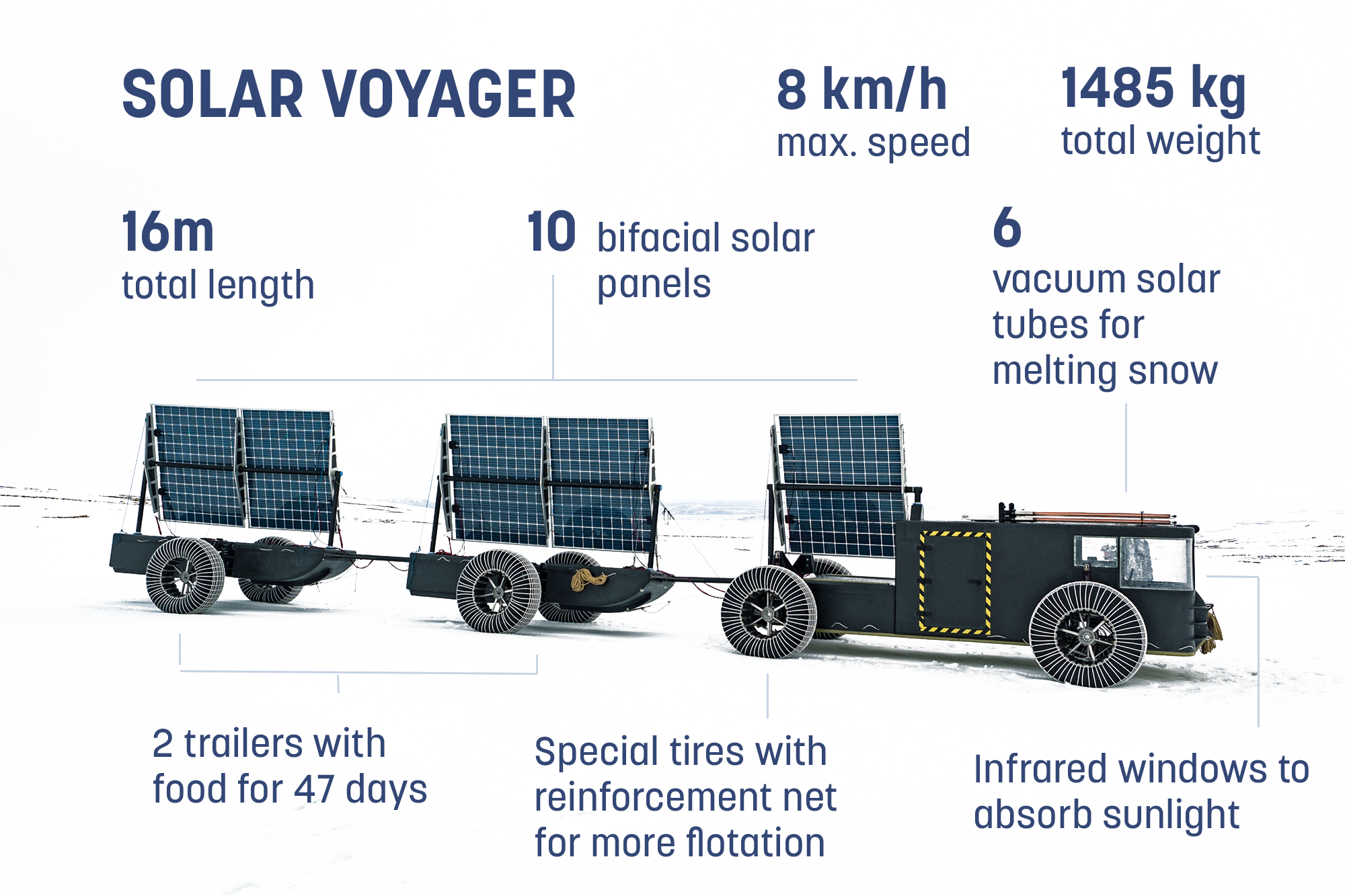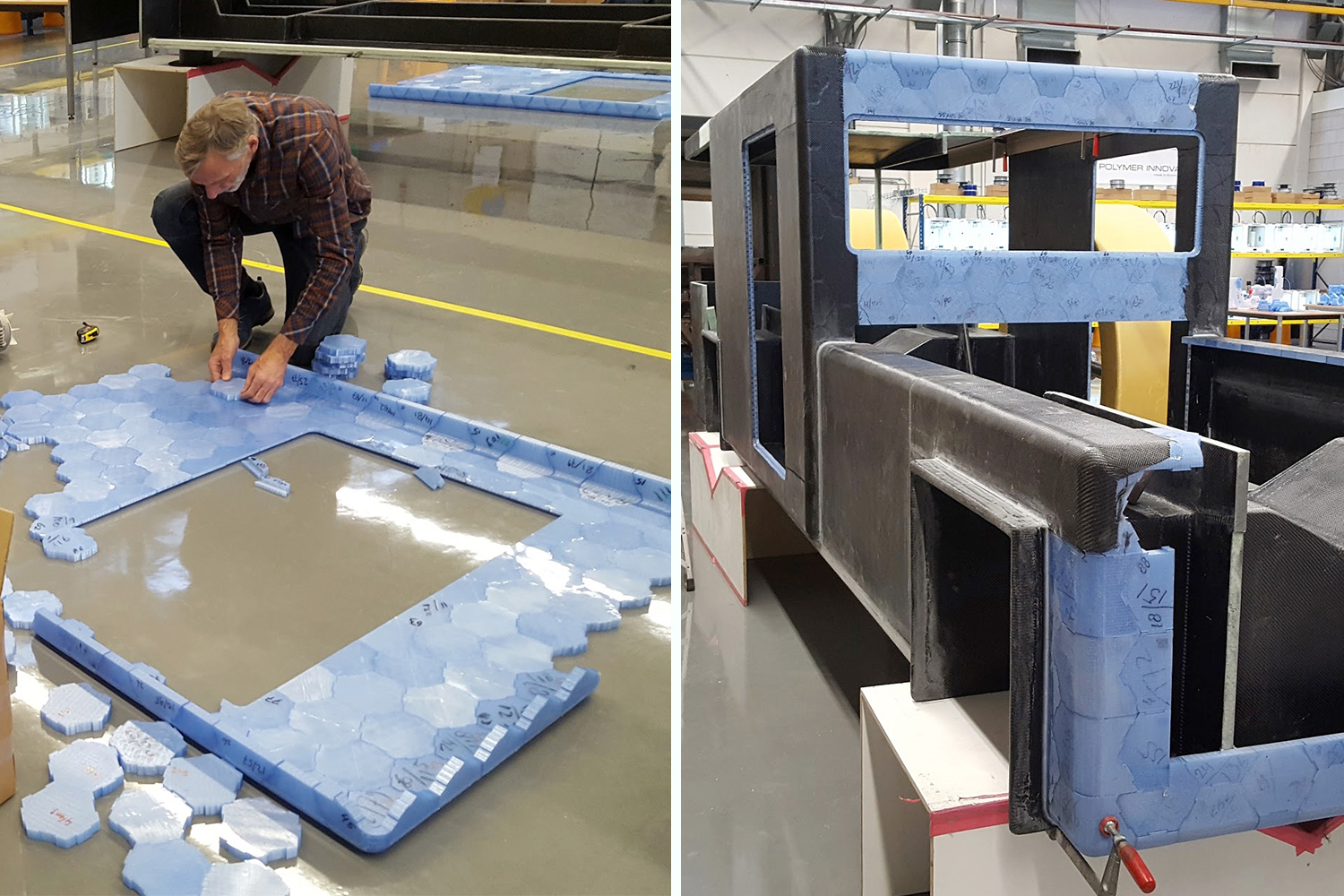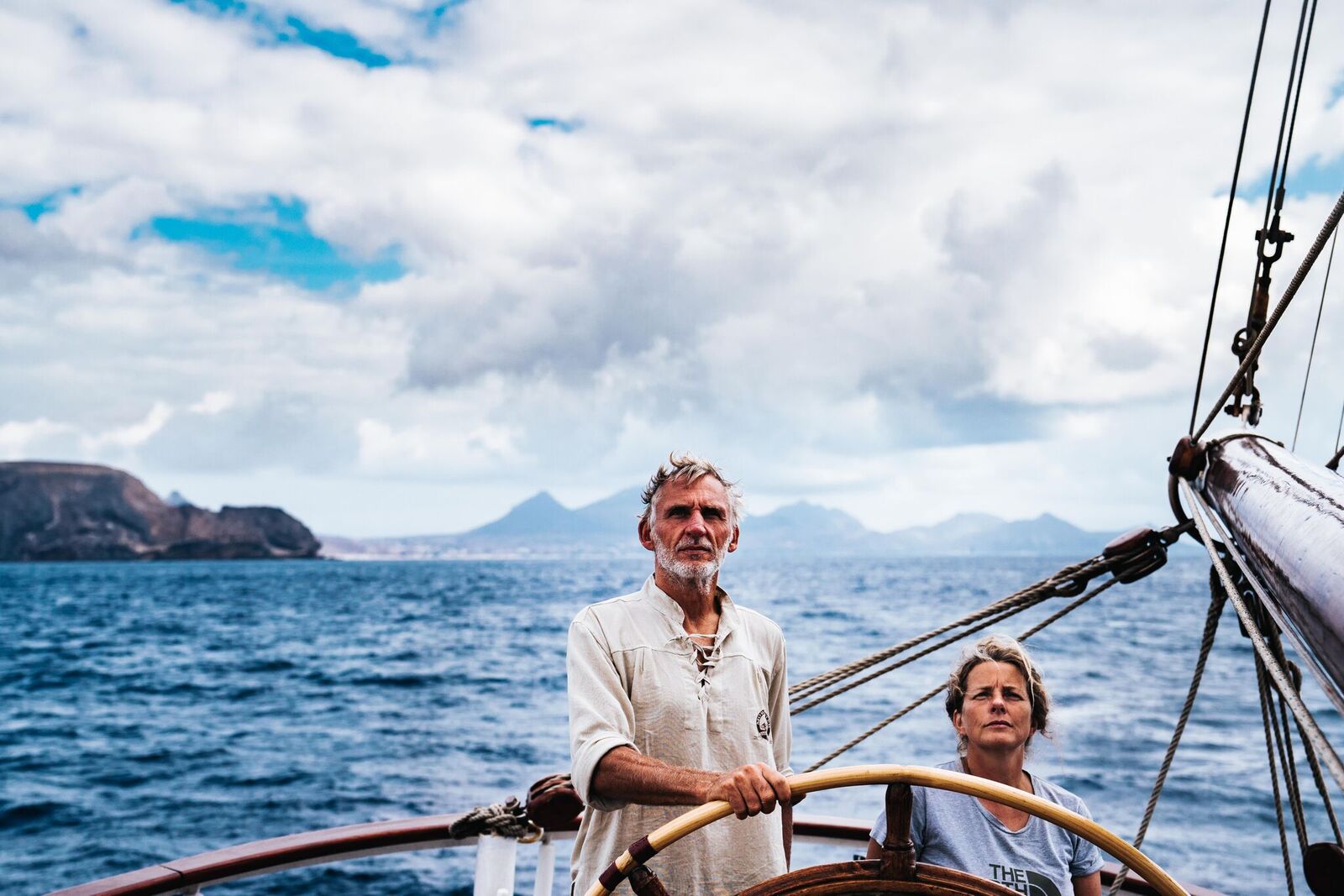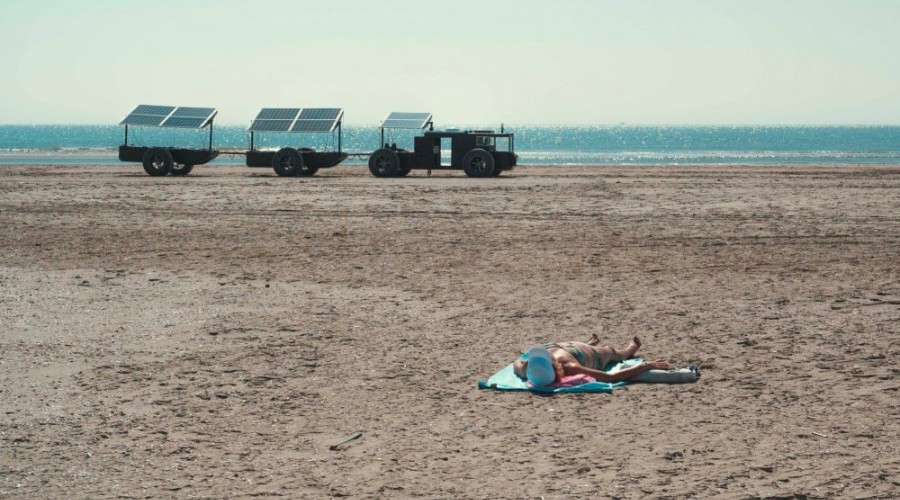FAQs
Find out more about Clean2Antarctica in different topics:
Expedition | Solar Voyager | Recycled plastic | Quest for Change | Our mission | Before C2A | Zero Waste Center
Expedition to the South Pole
How long the expedition will take?
The expedition is expected to take 30 days. We arrive to Union Glacier on the 26th of November and the final preparations will take 2 days. The expedition is expected to start on the 28th of November.
What is the route? Where will you start?
We will start at Union Glacier camp and then drive around 1200 km to the geographic South Pole. There we turn around, back to Union Glacier Camp.

Do you have a backup plan in case of emergency?
After analyzing the weather data provided by NASA and creating a list of all possible things that can go wrong, we have come up with a number of emergency action plans. The SV has a tracking system and the pilots will have to make a safety call every 12 hours. If one of these calls doesn't come through, the rescue mission will be dispatched immediately. The trailer can also be turned into sleds with a kite in case of problems with tires. There are many other emergency plans which we hope we will not have to put in action.
How will you make food?
We had to develop a special meal plan rich in carbs and fat (7,500 kcal in total) to make sure our pilots generate enough energy and stay warm. Most of the food is freeze dried and it will have to be mixed with water to make meals. We will get the water by melting snow.
How many people are going?
There will be 2 pilots (Edwin and Liesbeth) in the Solar Voyager. However they will be followed by a support group of 3 people who will film and only intervene in case of an emergency.
How will you get to Antarctica?
By plane. Unfortunately arriving by ship is impossible because of all the sea ice and the ice cliffs at the coast. We will fly from Punta Arenas, Chile to Union Glacier Camp.
Solar Voyager details
What are the Solar Voyager measurements?
The total length is 16 m with weight of 1485 kg (excluding 2 people and food). The measurements of the front truck are 2.70x5.50x2.20m with 3.80m wheelbase.
Has it been tested in strong crosswinds?
Not really. In Iceland we tested it as much as possible, but the catabolic winds that occure at Union Glacier are something that we will have to deal with on the spot. But if the winds are too strong, we can take down the top panels.
Has it been tested in the extreme cold?
While testing the Solar Voyager in Iceland the temperature didn't go below freezing. However, while the motor drives have been tested at -30°C, we couldn't test the Solar Voyager as a whole in these temperatures.
Is the cabin of the SV insulated?
There are two heating elements that can keep the batteries warm, but the crew will wear full clothing because the vehicle is not insulated.

How will you deal with sastrugis (sharp ice ridges)?
To avoid the bottom of the vehicle getting pierced, it has a Twaron layer. This material can be found in bulletproof vests as well. It is also more offroad than it looks; there can be at least 60 cm height difference between the wheels of one axis.
What are the solar panel specifications?
There are 10 bifacial solar panels with 325 Watt peak, compared to the 230 Watt peak for similar sized panels on most roofs. Each panel is 99x175cm and weighs about 25kg. Each panel can be taken down in case of extremely strong winds.
What are the battery specifications?
It drives directly on solar power, so the batteries are only for emergency situations. There are 2 batteries of 60kg each, with electric potential of 24 Volt each and a total power of 10kWh combined.
How far can the batteries go if there is overcast or cloudy days?
On a straight terrain, the batteries can work for up to 7-8 hours. But in rough terrain or when there are strong winds (which will be the case for Antarctica) the vehicle requires more energy. However, even when there is no direct sunlight, the batteries will be getting enough energy because by the end of December the daylight will reach 24 hours a day.
What is the white net around the tires for?
The tires are just inner tubes and are as soft as a balloon. To prevent the rims from touching the ground, we need the reinforcement net; It spreads the pressure evenly and keeps the tires round. The net is made from material 11 times stronger than steel (planned ground pressure: below 0.13kg/cm2 with the general pressure 3psi).
Why don't you use wind turbines?
We could use wind turbines, but it is always good to focus on one thing at a time (in our case, solar power and the outcome of that). At the end, it is not about the wind or solar power, it’s about human behaviour and how we can spread the idea of sustainability and inspire other people.
From plastic waste to Solar Voyager
What parts of made from plastic?
The entire chassis or body is made from the 3D-printed building blocks.
Where did you get the plastic from?
In the streets of Zwolle we collected plastic with children. From this we experimented with 3D-printing until Dufor helped to turn it into industrially recycled filament (the cable for 3D printers).

What type of plastic did you use and why?
We used PET, the type of plastic most commonly found in plastic bottles. The reasons for choosing PET are that it is easy to recycle and it is most compatible with the epoxy resins needed for the outer carbon layer. About 200 kg of plastic was used for the entire chassis of the Solar Voyager.
Won’t the plastic corrode at extremely low temperatures?
No, plastic will not corrode. This is exactly the reason why we printed 3D knobes instead of using regular screws, which will not sustain the -30°C.
Did you make these building blocks yourself?
Yes, we used forty 3D-printers to make these HexCores, which we designed ourself, inspired by nature's strongest shape.
Quest for Change
Why are you organising the Quest for Change?
To help companies start their own adventure. Innovation and progress happens when you take steps into unknown territory and that is exactly what happens when a company lets 20 students brainstorm on the future.
Who are the people on board?
The groups is around 20 people between 18-28 years, who have been selected to form a diverse team. Our three teams are international and feature backgrounds from engineering
Can I still apply?
No, the groups have already been selected.
Our mission
How do you connect the expedition to sustainability?
If driving to the South Pole on solar power was our ultimate goal, we would still be proud of our mission because no one has ever done it before and the technology we developed can become a prototype for Antarctic research drones. However, it's not about technology but about starting experiments and discovering what's possible with waste. To reach a circular society, we need to start doing things differently. Our expedition is an example how far you can get when you simply start doing things differently instead of talking about abstract solutions.
How do you deal with the negative impacts of your expedition?
We're aware of our flight emissions and the issues around batteries and electronics. We have never pretended we're 100% clean but that's also not our goal. We want to push the boundaries of what seems possible with renewables and we want to take responsibility for the negative impacts. We will compensate by planting trees in Iceland. Why Iceland? Because during our tests with Arctic Trucks we saw that they don't have a lot of trees :-)
Are you also taking scientific research with you?
We do in fact have three research projects on board:
- First ever cosmic rays measurements in Antarctica on ground level over a wider area with Nikhef
- Seismologic research about ice with Innoseis
- Testing a new low power satellite system from Hiber
Why Antarctica?
If you make it in Antarctica, you can make it anywhere. If the test for our technology in the most extreme conditions is succesful, it can be used in different conditions all around the world, while reducing the environmental impact. Aside from technology, there is a need to raise awareness about the importance of Antarctica as the only zero waste continent, protection of which has to be of high priority for the world. Ignorance of the rate at which the ice is melting and commercial interest in exploiting the resources found in Antarctica can lead to dramatic negative impact for many people around the world.
Before C2A
How it all started?
Liesbeth and Edwin were making dinner, when they tossed away another plastic packaging. It was the straw that broke the camel’s back. They turned around their trashcan and their mindset. Why is plastic suddenly worthless? Why do we blame the government or the supermarket? The next day they went to the butcher with their own reusable packaging. It was an uncomfortable situation, but a moment of success that set off a personal adventure.
About Liesbeth and Edwin, before C2A:
Edwin (52) was an entrepreneur and Liesbeth (50) used to work in a hospital pharmacy. They grew up together in the same neighborhood in Zaandam where they still live with their 3 children. The project started at home so all the family was and still is involved in order to support a zero waste lifestyle. Starting with their own trash they explored ways to make use of the large amounts of plastic being thrown away. So they turned plastic waste into the foundation of C2A project.

About the Zero Waste Center
What is the idea behind the ZWC?
We are now developing the idea of a Zero Waste Center, to help companies with their social innovative entrepreneurial behavior to gain new insights that possibly lead to new zero waste strategies. The ZWC is a comprehensive zero waste implementation consultancy. Zero Waste services are focused on environmental change, zero waste in business processes, and enhance the creative entrepreneurial activity.



